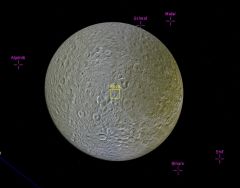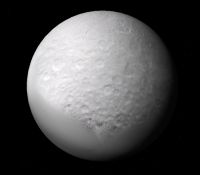Difference between revisions of "Rhea"
Jump to navigation
Jump to search
(Added table item.) |
(Updated infobox.) |
||
| Line 14: | Line 14: | ||
!bgcolor="lightsteelblue" colspan="2"|Planetary mean orbits | !bgcolor="lightsteelblue" colspan="2"|Planetary mean orbits | ||
|- | |- | ||
| − | |width="30%"|Epoch||align="right" width="50%"| | + | |width="30%"|Epoch||align="right" width="50%"|1999 |
|- | |- | ||
| − | |width="30%"|Semimajor axis (a)||align="right" width="50%"| | + | |width="30%"|Semimajor axis (a)||align="right" width="50%"|527100000 m |
|- | |- | ||
| − | |width="30%"|Eccentricity (e)||align="right" width="30%"|0. | + | |width="30%"|Eccentricity (e)||align="right" width="30%"|0.0009 |
|- | |- | ||
| − | |width="30%"|Inclination (i)||align="right" width="30%"| | + | |width="30%"|Inclination (i)||align="right" width="30%"|0.327158901° <br> (0.00571 radian) |
|- | |- | ||
| − | |width="30%"|Longitude of the ascending node (LAN, ☊)||align="right" width="30%"| | + | |width="30%"|Longitude of the ascending node (LAN, ☊)||align="right" width="30%"|1.094922346° <br> (0.01911 radian) |
|- | |- | ||
| − | |width="30%"|Longitude of periapsis (ϖ)||align="right" width="30%"| | + | |width="30%"|Longitude of periapsis (ϖ)||align="right" width="30%"|206.9638148° <br> (3.6122 radian) |
|- | |- | ||
| − | |width="30%"|Mean longitude (L)||align="right" width="30%"| | + | |width="30%"|Mean longitude (L)||align="right" width="30%"|85.69729742° <br> (1.4957 radian) |
|- | |- | ||
!bgcolor="lightsteelblue" colspan="2"|Selected physical parameters | !bgcolor="lightsteelblue" colspan="2"|Selected physical parameters | ||
| Line 38: | Line 38: | ||
|width="30%"|SidRotPeriod||align="right" width="30%"|390411 seconds (108.4475 hours or 4.5 days) | |width="30%"|SidRotPeriod||align="right" width="30%"|390411 seconds (108.4475 hours or 4.5 days) | ||
|- | |- | ||
| − | |width="30%"|SidRotOffset||align="right" width="30%"| | + | |width="30%"|SidRotOffset||align="right" width="30%"|0 |
|- | |- | ||
|width="30%"|Obliqutiy||align="right" width="30%"|0.4895 | |width="30%"|Obliqutiy||align="right" width="30%"|0.4895 | ||
| Line 44: | Line 44: | ||
|width="30%"|LAN||align="right" width="30%"|6.09808 | |width="30%"|LAN||align="right" width="30%"|6.09808 | ||
|- | |- | ||
| − | |width="30%"|Note||align="right" width="30%"|*Elements given are from Rhea.cfg ( | + | |width="30%"|Note||align="right" width="30%"|*Elements given are from Rhea.cfg (osaturn.zip) |
|} | |} | ||
Revision as of 02:50, 5 August 2024
| Rhea | |
|---|---|

| |
| Rhea in Orbiter 2016 with D3D9 client | |
| Designation | |
| Name | Rhea |
| Reference body | Saturn |
| Planetary mean orbits | |
| Epoch | 1999 |
| Semimajor axis (a) | 527100000 m |
| Eccentricity (e) | 0.0009 |
| Inclination (i) | 0.327158901° (0.00571 radian) |
| Longitude of the ascending node (LAN, ☊) | 1.094922346° (0.01911 radian) |
| Longitude of periapsis (ϖ) | 206.9638148° (3.6122 radian) |
| Mean longitude (L) | 85.69729742° (1.4957 radian) |
| Selected physical parameters | |
| Mean radius | 764000 km |
| Mass | 2.49×1021 kg |
| Rotation elements | |
| SidRotPeriod | 390411 seconds (108.4475 hours or 4.5 days) |
| SidRotOffset | 0 |
| Obliqutiy | 0.4895 |
| LAN | 6.09808 |
| Note | *Elements given are from Rhea.cfg (osaturn.zip) |
Rhea is the ninth-largest moon in the Solar System and the second-largest moon of Saturn. Rhea was discovered by Giovanni Domenico Cassini on 23 December 1672 about the same time he discovered Dione, Iapetus, and Tethys, but the name Rhea referred to by John Herschel stuck.
Rhea in Orbiter
Rhea was first introduced in Orbiter with the release of Orbiter 2002 in April 2002.
| <center?Orbiter versions and add-ons which include Rhea | |||||||
| Add-on | Source | Version | Author | Type | Release Date | Compatibility | Wiki article |
|---|---|---|---|---|---|---|---|
| Moons of Saturn Part 3 | AVSIM | Rolf Keibel | Scenery | 19 October 2002 | |||
| Orbiter 2002 | O-F Resources | 020419 | martins | Orbiter Download | 19 April 2002 | Orbiter 2002 | |
See also
Gallery
Rhea as seen by the Cassini spacecraft on 26 November 2005
From Wikimedia Commons
| edit The Solar System | |
|---|---|
| Central star |
Sun (Sol) |
| Planets |
Mercury - Venus - Earth - Mars - Jupiter - Saturn - Uranus - Neptune |
| Natural satellites |
Moon - Phobos - Deimos - Io - Europa - Ganymede - Titan - more... |
| Add-ons |
Planets - Dwarf Planets - Small objects - Natural satellites - Alternative star systems |
 | This natural satellite related article is a stub. You can help Orbiterwiki by expanding it. |

